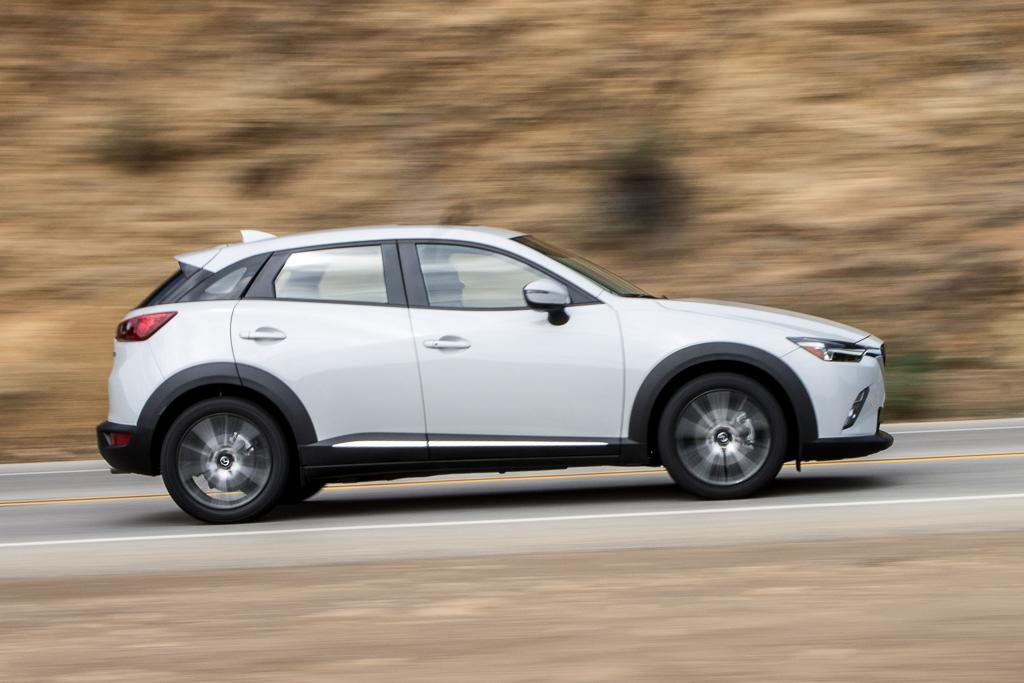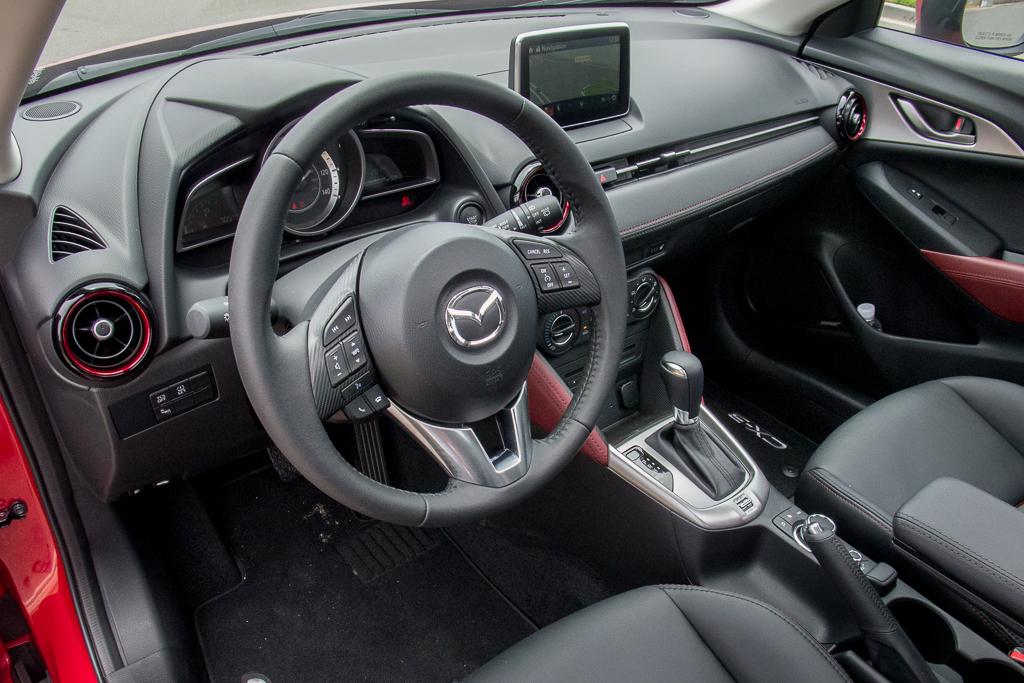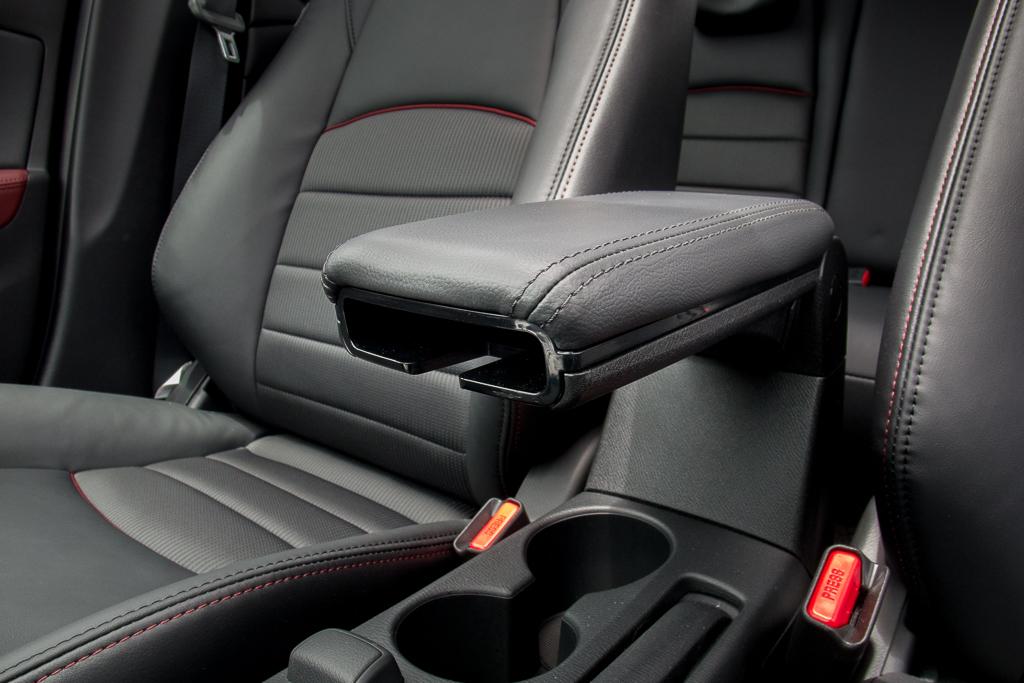
In a burgeoning class of hatchback cars masquerading as small SUVs, the Mazda CX-3 is ... a hatchback. It's a sharp-looking one with a quality interior and high gas mileage, but apart from its optional all-wheel drive, the only thing distinguishing it from Mazda's own Mazda3 compact hatchback is interior space -- of which it has less. Oh, and also its price, which is higher. (See our earlier post on trim levels and pricing.)
Related: 2016 Mazda CX-3: First Look
Having established that, I predict the CX-3, which goes on sale this fall, will excel in the market and demonstrate definitively why automakers are producing these subcompact SUVs and successfully selling them for more money. Americans prefer SUVs to hatchback cars and (gasp!) station wagons, practical considerations be damned.
Exterior
The CX-3 looks great. Its snub-nosed front end recalls the comparably sized Mitsubishi Outlander Sport, which has a nice design that the automaker unwisely abandoned for the larger 2016 Outlander. The CX-3 also has the kind of gray trim along its rocker panels and wheel arches seen on other direct competitors, such as the Subaru XV Crosstrek, as well as the upscale Audi Allroad - both current market stars.

2016 Mazda CX-3; Manufacturer Image
Frankly, apart from the butched-up body, the CX-3's SUVness is questionable. It offers optional all-wheel drive, which the Mazda3 hatchback lacks, but its ride height is just 0.2 inch higher and its ground clearance is 6.1 inches - the same as the hatchback. It's probably the most grounded-looking of the subcompact SUVs, though the Mini Cooper Countryman sits 5.9 inches off the ground, and the XV Crosstrek and Jeep Renegade Trailhawk both substantiate their go-anywhere image with 8.7 inches of ground clearance.
How It Drives
I expected the CX-3 -- being a relative low-rider, and a Mazda -- to be one of the best-driving models of this type, and it delivered, to a degree. Its greatest strength is its dynamics. Mazda staged the vehicle's national introductions outside of Los Angeles and boldly turned reviewers loose on canyon roads, which the CX-3 gobbled up.
Though the rear end employs a relatively inexpensive but space-efficient torsion-beam suspension rather than a fully independent setup, it seemed unfazed in the blissfully relentless switchbacks and hairpins. The road holding was excellent with Yokohama Avid S34 all-season tires. The Touring trim level with front-wheel drive and 16-inch alloy wheels was good, but I preferred the all-wheel drive on the top trim level, Grand Touring, which had 18-inch wheels. The base trim level, Sport, wasn't available. All three offer front- or all-wheel drive and share the same suspension tuning. I felt no great difference in ride quality between the 16- and 18-inch wheels. Sporty but comfortable.

2016 Mazda CX-3; Cars.com photo by Joe Wiesenfelder
Though the chassis is impressive, I wasn't bowled over by the steering. Mazda tuned the electric assist nicely, with good torque buildup off-center, and the ratio is well-suited for the car, but overall feedback wasn't up to Mazda standards. It felt a bit artificial.
The CX-3 has a 2.0-liter four-cylinder whose 146 horsepower compares to the Chevrolet Trax, Honda HR-V, Outlander Sport and XV Crosstrek, but its curb weight is much lighter than all four, by as much as 289 pounds for all-wheel-drive models. It seems a recipe for quick sprints, but the CX-3 felt a little poky to me, even with just two adults and no luggage onboard. This isn't the quickest vehicle class, though the Renegade, Fiat 500X and Countryman S (with all-wheel drive) offer 15 to 35 hp more.
We'll need to do some time trials in the future, but it's possible the feeling of modest acceleration was just that: a feeling. The HR-V has a continuously variable transmission, and the Fiat and Jeep have nine-speed automatics, both with a wide range of gear ratios that help eke the most out of a small engine, especially off the line. Note that the HR-V's CVT, though a good one, still comes with the whine and drone we don't care for, and the nine-speed shared by the two other models has a terrible case of indecision and likewise induces engine fury when it hops down to low gears, for better and worse.
Compare the CX-3, whose broad engine torque band and responsive six-speed automatic provide vastly more pleasing operation in normal driving. But because there are just six speeds, sometimes you can stand on the accelerator and it doesn't seem to do anything: Just modest acceleration and no kickdown to a lower gear -- because at some speeds there just isn't one to go to, even when in Sport mode.
The CX-3 earns points for matching the class-leading HR-V in gas mileage without higher gear counts or a CVT: an EPA-estimated 31 mpg combined with front- and 29 mpg combined with all-wheel drive.
Interior
With all of its new models, the subcompact SUV class has some nice interiors, and the CX-3 is right up there. The Sport has cloth seats, the Touring a nice combination of cloth and imitation leather, and the Grand Touring genuine leather with faux suede seat inserts and door panels.

2016 Mazda CX-3; Cars.com photo by Joe Wiesenfelder
Rather than using crappo Thin-Mint-style air-conditioning vents, Mazda included intricate, nicely finished vents, complete with air-volume knobs. Prominent items like this are a wise place for automakers to spend some money. It pays off. The 7-inch touch-screen display (with knob-based controller on the center console for when the car is in motion) is another high-value standard item.
The main shortfall I noted was the displays flanking the Touring's speedometer gauge were too dim to see, even in overcast daylight. The Grand Touring, which has a central tachometer instead with an inset digital speedometer and the same bookending displays, didn't have this problem. The Grand Touring also adds the Active Driving Display (a head-up display using a small, transparent window atop the dashboard).
The most unique feature is a smartphone cavity in the center armrest (pictured below). Interesting idea, but the tab intended to hold the device in place marred my phone's plastic-film screen protector. Proceed with caution.

2016 Mazda CX-3; Cars.com photo by Joe Wiesenfelder
Cargo
The CX-3's cargo volume behind the backseat is roughly half that of several competitors, which might explain why its backseat legroom isn't bad - roughly middle of the pack. It has less headroom than all the others, however, both front and rear. The 2016 Mini Countryman is one competitor that offers less cargo room with its seats folded. The Mazda's maximum cargo volume trails other competitors by at least a few cubic feet.
I'll be sharing more details on the CX-3's performance, amenities and active safety systems in an upcoming review.
No comments:
Post a Comment